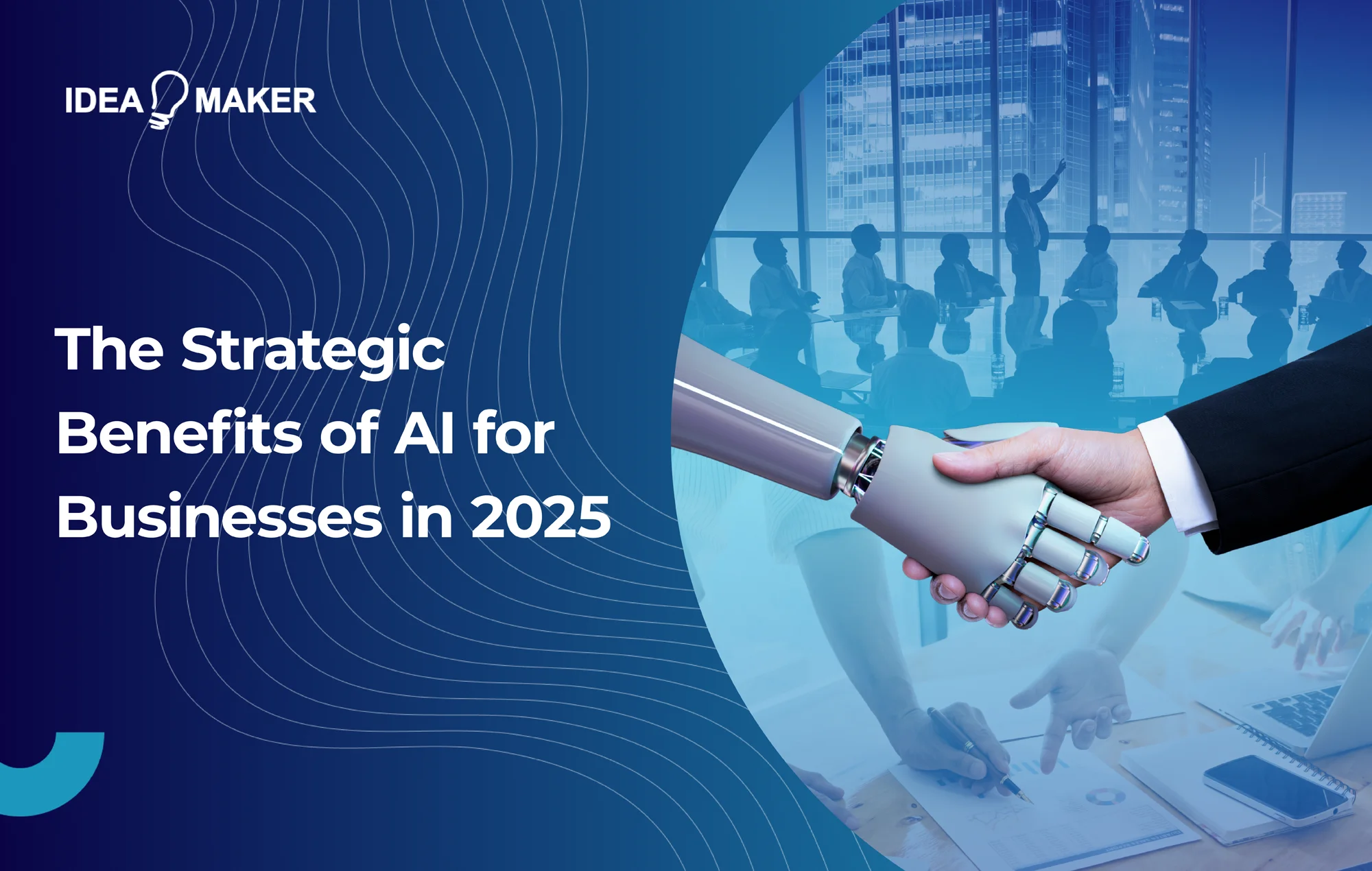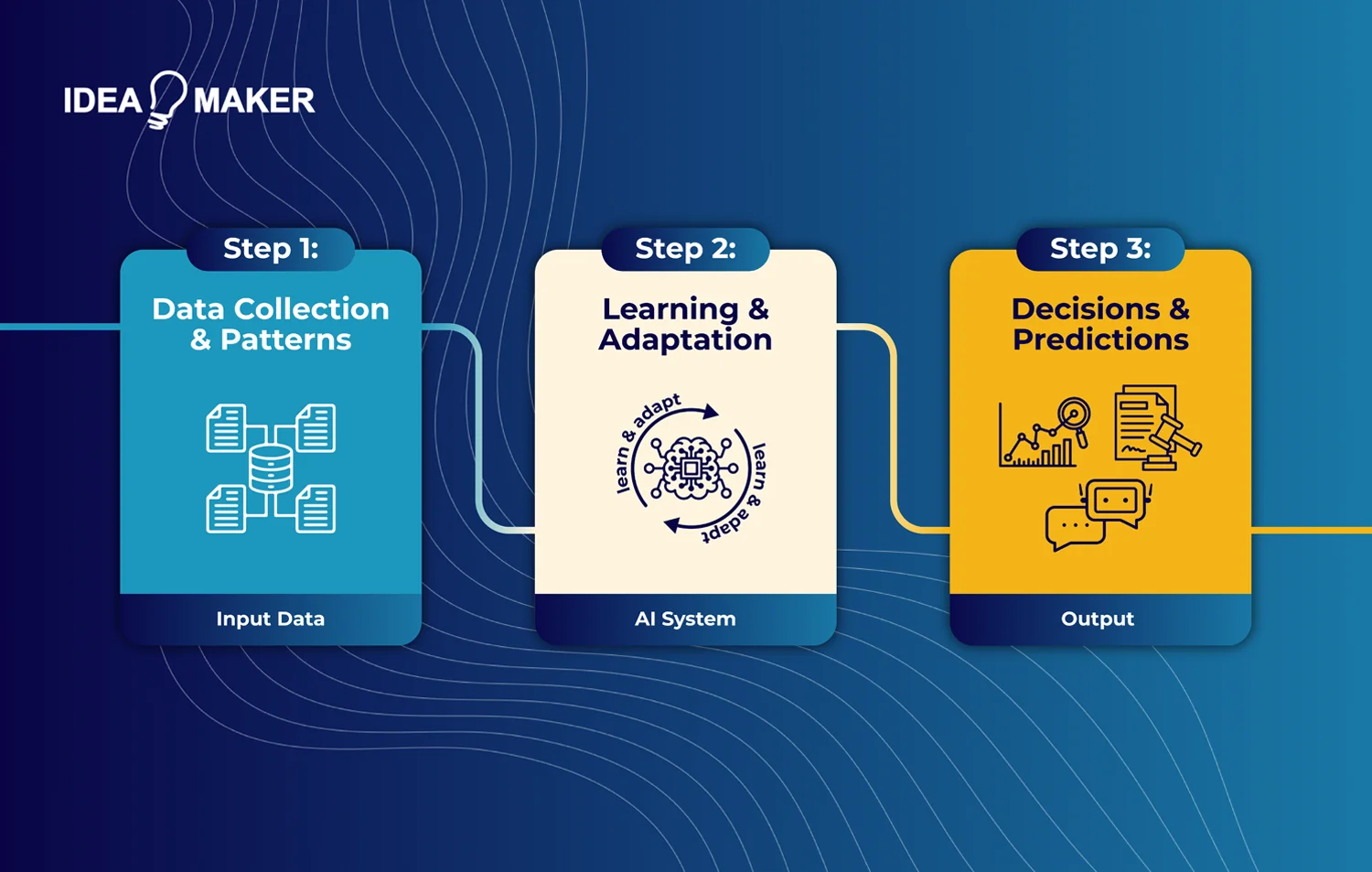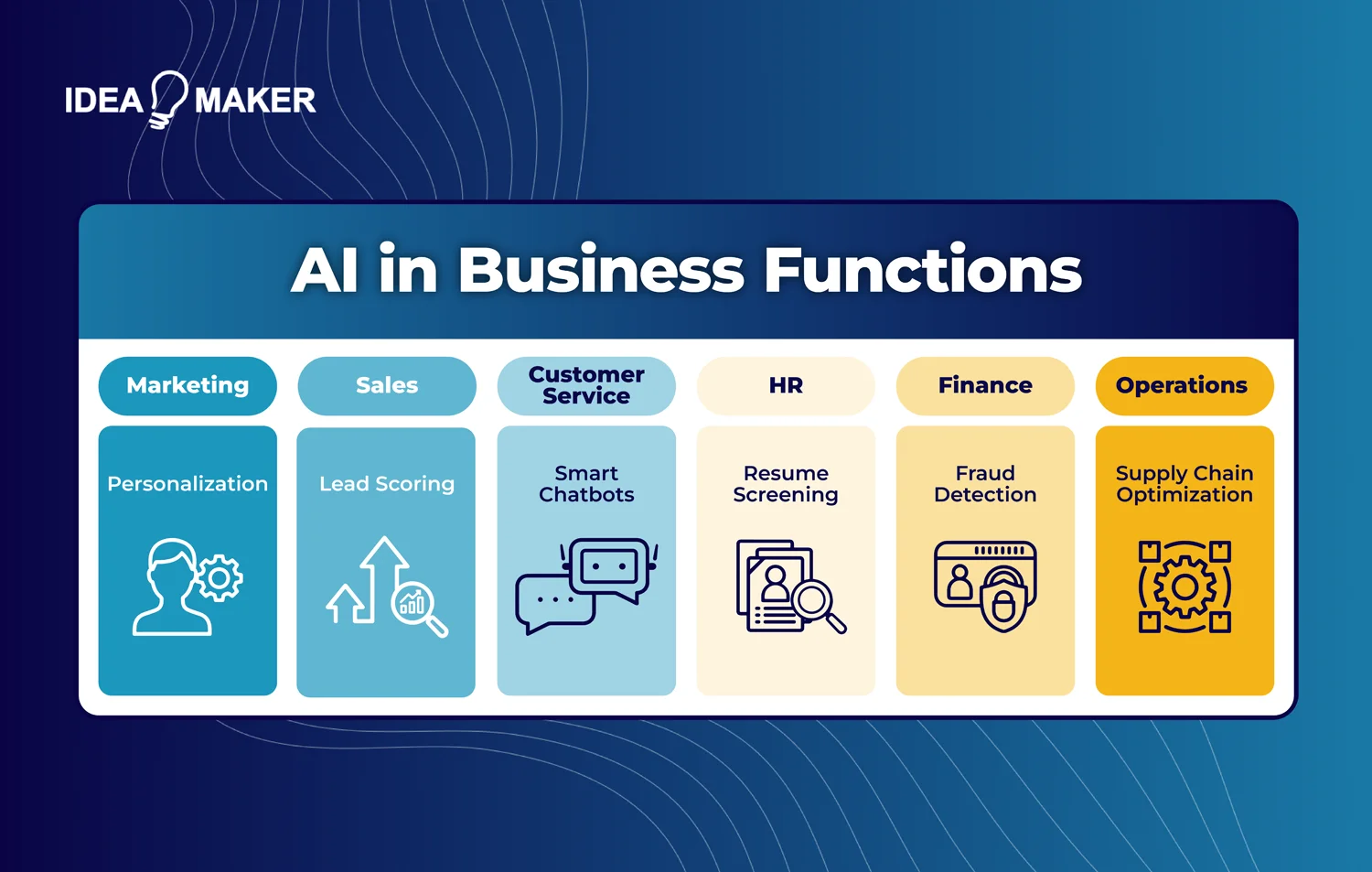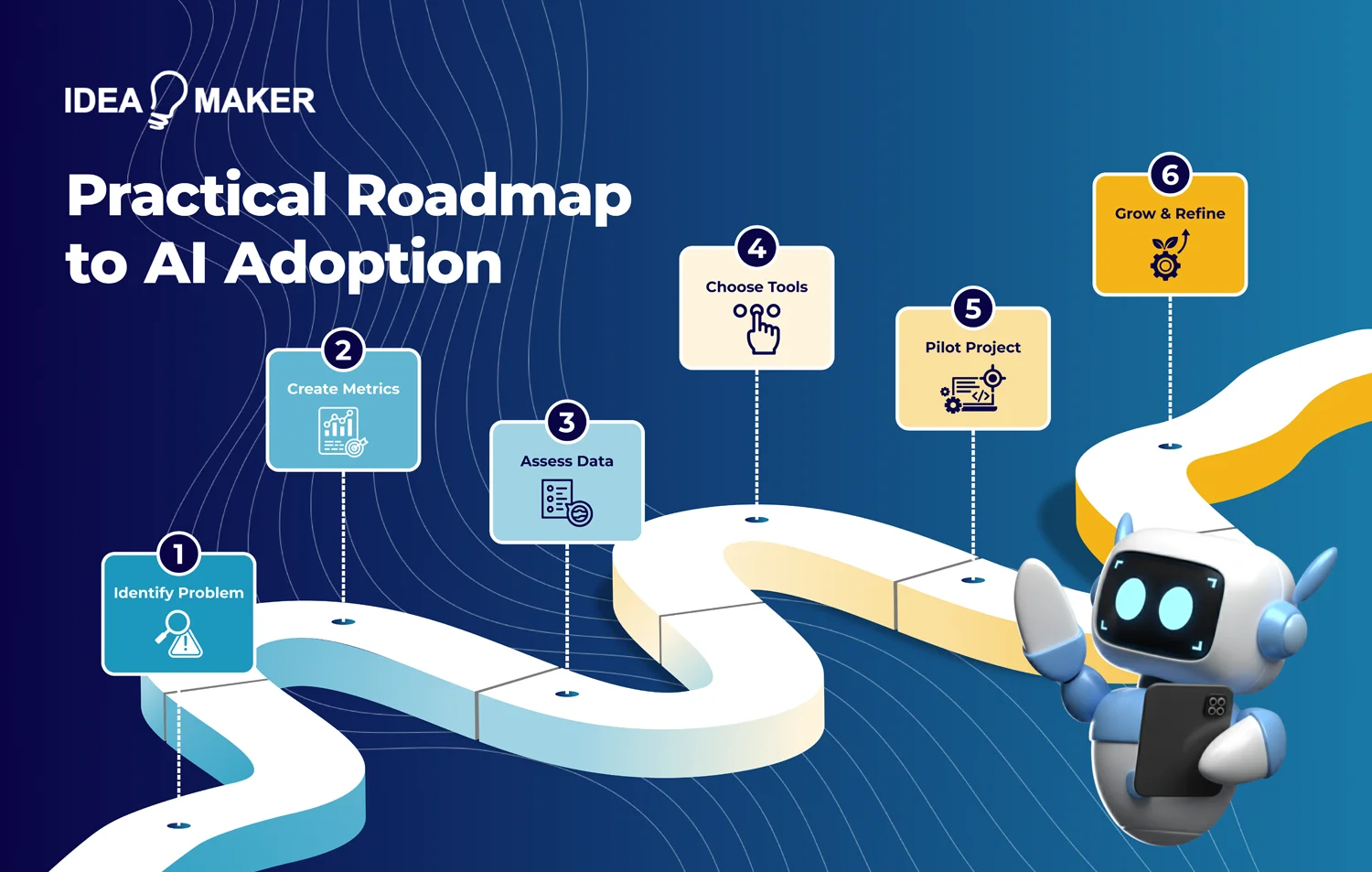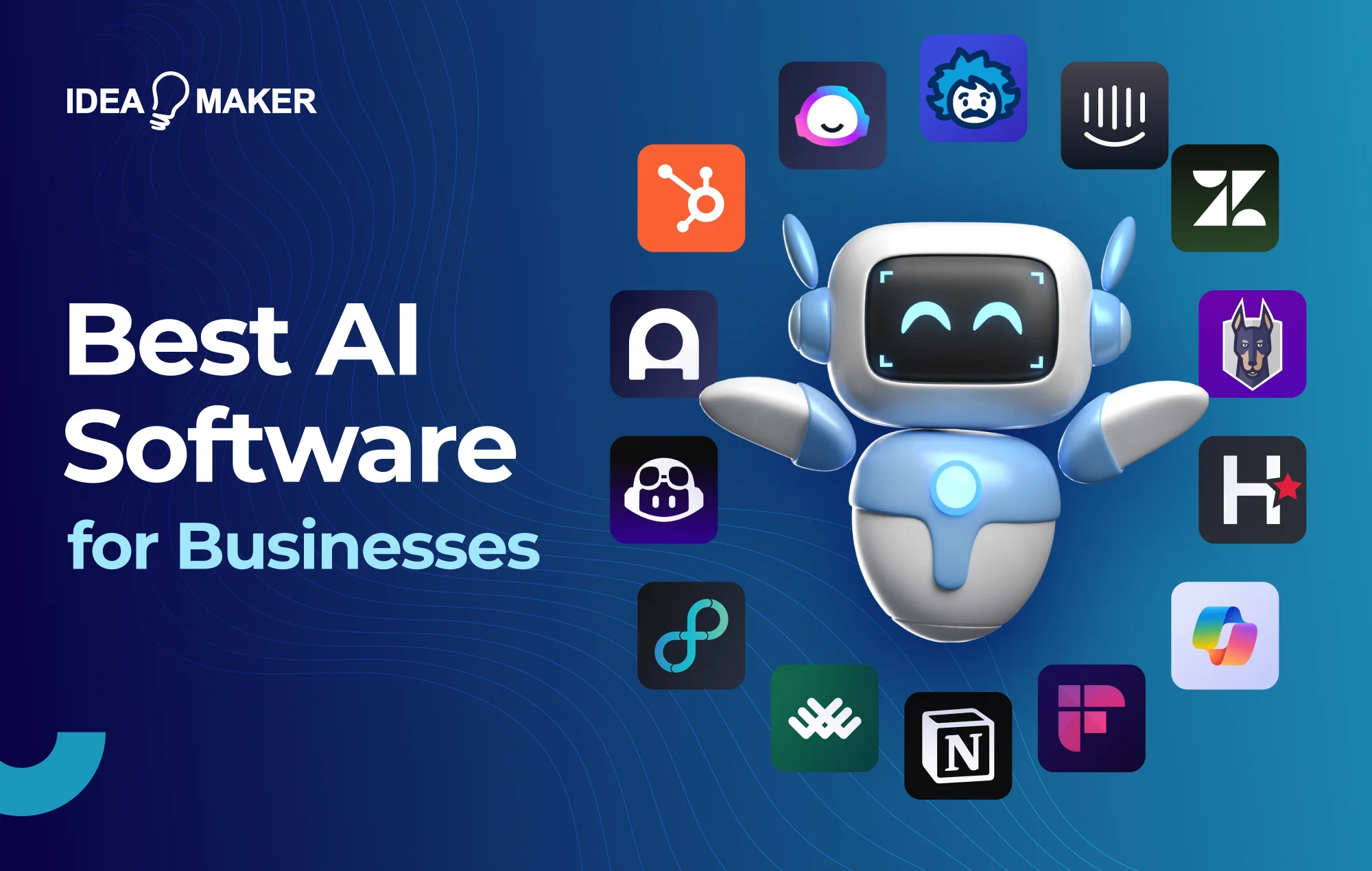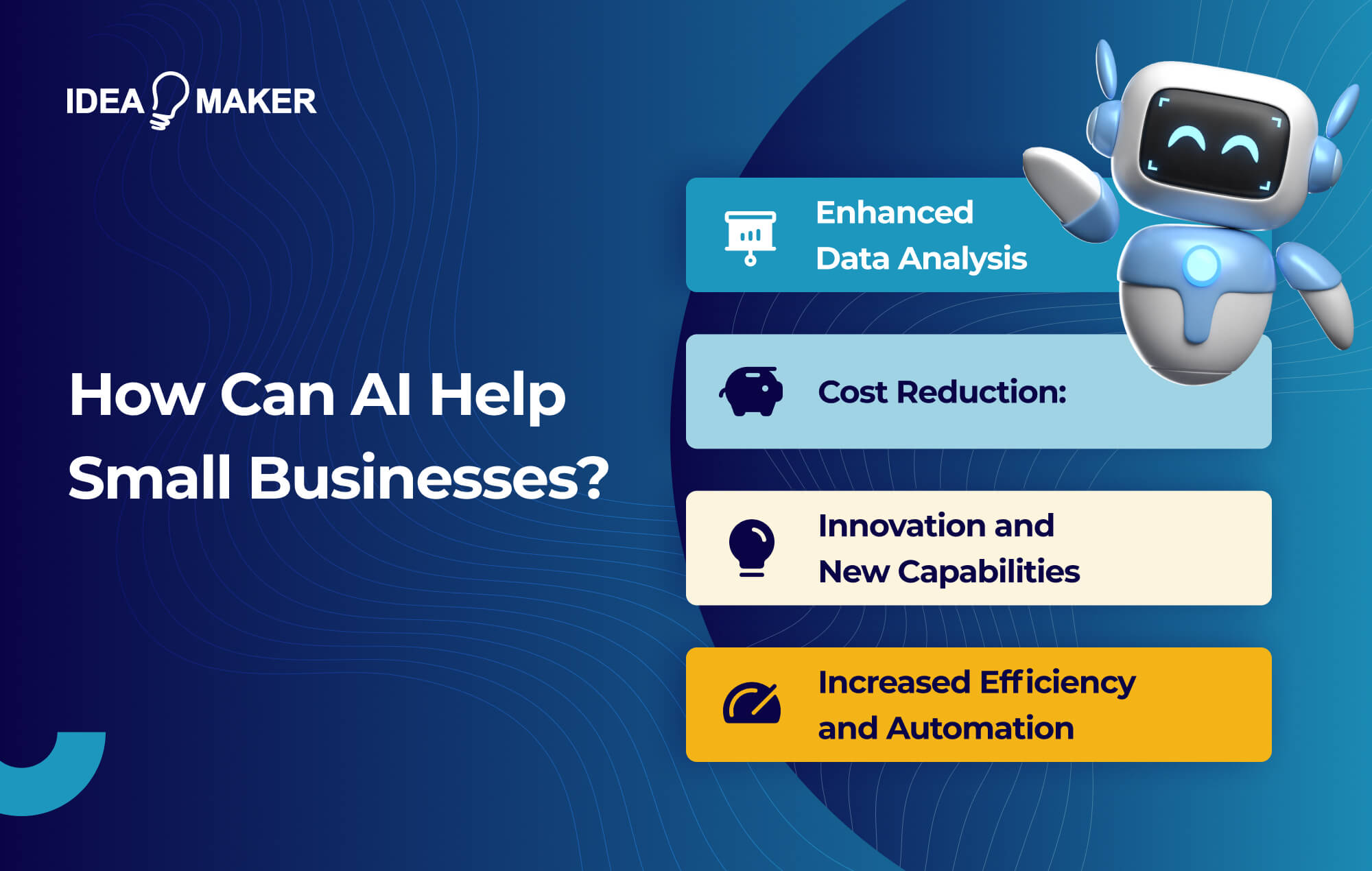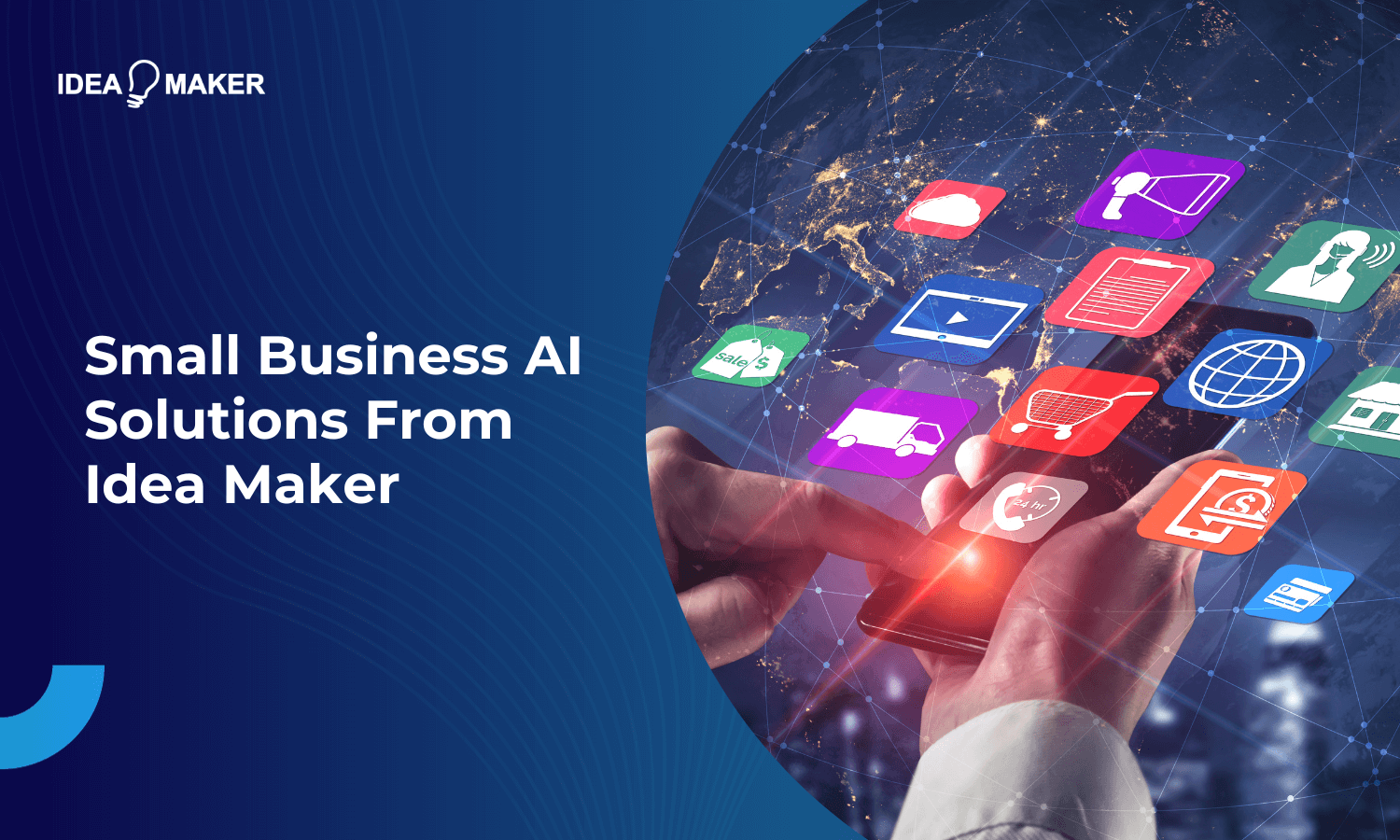AI is ubiquitous in every modern business today, from marketing and sales to HR, finance, and product development. According to a recent PwC report, over the next decade, AI is projected to contribute $15.7 trillion to the global economy due to improvements in productivity and customized consumer interactions. Across all these sectors, the more widespread it becomes, the more important it is for leaders to understand what AI for business is and how to leverage this technology to stay competitive. This article explores the benefits of AI for business, offering a clear framework to help identify the most impactful opportunities for growth and innovation.
Table of Contents
What is AI, and How Is It Applied in a Business Context?
AI for business refers to the use of intelligent software systems that can analyze data, learn from patterns, and make decisions or predictions with minimal human intervention. AI integration in business transforms the traditional rule-based systems into dynamic, adaptive AI business solutions.
In practice, AI is used in various real-world business operations across many industries to make operations more efficient. It is achieved by automating repetitive processes, analyzing massive amounts of data, and predicting future outcomes. For example, companies use AI to streamline supply chain operations, optimize marketing campaigns, enhance customer experiences, and optimize risk assessment.
Key AI Technologies Empowering Small Businesses
AI isn’t just a luxury reserved for tech giants anymore; it’s now within reach for small and mid-sized businesses too, reshaping how they operate, compete, and grow. AI delivers value to small and mid-sized businesses through several key applications:
- Machine Learning (ML): ML models analyze historical data, detect recurring patterns, and make informed decisions. ML powers most aspects of sales forecasting, customer segmentation, and marketing for small businesses.
- Natural Language Processing (NLP): NLP enables machines to understand and generate human language. Technologies like chatbots, voice assistants, and email/ticket sorting automation tools are powered by NLP.
- Computer Vision: This field of AI interprets visual data such as images or videos. Small businesses with physical products can utilize computer vision for inventory tracking or security monitoring.
- Generative AI / LLMs: Today, businesses can automate anything from blog posts and product descriptions to email campaigns or legal templates using large language models (LLMs) like GPT-4, Gemini, Claud, etc.
- Automations: AI-enabled automation tools automate repeatable administrative tasks like invoice processing, lead qualification, and scheduling etc. This saves a significant amount of time and reduces errors.
Key Industries Leading AI Adoption
While AI is expanding in nearly every sector, the following industries are leading the charge with more mature, high-impact use cases:
- Retail & E-commerce
- Healthcare
- Customer Service
- Finance & Banking
- Manufacturing
- Marketing & Advertising
Operational Efficiency and Intelligent Automation
Efficiency is more about gaining an edge than achieving a goal in today’s business world. One of the most immediate benefits of artificial intelligence in business is to automate routine tasks, enhance resource utilization, and create streamlined workflows. It intends to take teams away from manual labor work and instead focus on more value-generating activities: AI delivers these advantages through a wide range of targeted applications:
Process Streamlining with Intelligent Workflows
AI-enabled workflows are designed to streamline business processes through intelligent automations. 89% of marketers are already using AI business solutions in their workflows.
For example, a B2B SaaS company can use AI to automate parts of its lead nurturing funnel. When someone downloads a whitepaper, an AI system can classify the quality of the lead and trigger an email sequence. After that, if certain conditions are met, it alerts sales and automatically schedules a follow-up with no human intervention required.
Reducing Manual Tasks Through Automation
Manual, repetitive tasks slow teams down and introduce costly errors. AI-driven automation addresses this problem directly by automating mundane tasks across departments.
For instance, in finance, AI can automatically tag expenses, process invoices, and identify outliers in real-time. Similarly, in customer service, AI chatbots can answer FAQs, route tickets, or even do basic issue resolution. Likewise, in HR, AI can automatically scan resumes, schedule interviews, and do onboarding for new hires.
Scale Energy and Cost Optimization
AI is also increasingly used to minimize power usage and reduce operational costs. Manufacturing and other data-intensive industries utilize AI systems to analyze consumption habits and identify waste or diagnose machinery failures before they occur. Additionally, it dynamically allocates power usage depending on real-time demand.
For example, Google’s DeepMind AI was implemented to reduce energy consumption in its data centers by 30%, saving the company millions of dollars each year.
If more broadly utilized, in addition to energy savings, AI integration in business can also prevent overstaffing and waste, and accurately predict demand. Hence, it minimizes storage and efficiently utilizes cloud resources, resulting in cost savings without sacrificing performance.
Functional Benefits of AI Across Business Units
The benefits of artificial intelligence in business are not limited to a single sector. The following section discusses the top benefits of AI for business growth across industries, along with the best AI tools for businesses that deliver the most significant impact.
AI in Marketing
- Dynamic Personalization: AI generates personalized product recommendations, content, and email campaigns based on customers’ interactions with the website using tools like Dynamic Yield and Adobe Sensei.
- Campaign Optimization: AI optimizes ads and media buying strategies in real-time to enhance ROI using tools such as Albert.ai and Phrasee.
- Sentiment Analysis: AI analyzes social media comments and customer feedback to determine the customer satisfaction level using tools like MonkeyLearn and Sprout Social.
AI in Sales
- Lead Scoring: Tools like HubSpot’s AI-powered CRM or Salesforce Einstein analyze leads using behavioral signals and historical data to determine their likelihood of converting into customers.
- Sales Forecasting: AI can predict deal outcomes, analyze pipeline health, and deliver more accurate forecasts of marketing generated using platforms such as Clari and Gong. AI-powered sales forecasting cuts prediction errors by 50% and reduces forecasting time by 80% compared to traditional methods.
- Conversational AI: AI assistants like Drift or Conversica use conversational AI to interact with leads in real time and personalize conversations to qualify prospects and book meetings without human oversight.
AI in Customer Service
- Chatbots & Virtual Assistants: Tools like Zendesk AI & Intercom Fin manage FAQs, guide users through self-service options, and escalate complex issues when necessary.
- Smart Ticket Routing: AI prioritizes and routes the incoming ticket to the relevant team based on urgency, sentiment, and topic using tools like Freshdesk, coupled with Fredy.
- Sentiment Detection: Qualtrics XM and IBM Watson Tone Analyzer help organizations find dissatisfied customers instantly so that their support team knows before any issues escalate.
AI in HR
- Resume Screening: AI helps HR teams to automatically evaluate resumes, schedule video interviews, and screen candidates for skills, culture fit, and even their likelihood of getting hired. Examples of such tools are HireVue and Pymetrics.
- Employee Sentiment Analysis: Tools such as Peakon and Lattice utilize NLP to track team morale and identify issues before they lead to poor performance.
- Workforce Planning: AI processes historical and real-time data to predict workforce demands and ensure the effective distribution of talent across teams using tools like Eightfold AI and SAP SuccessFactors.
AI in Finance
- Expense Management: Expense automation tools use AI to auto-categorize transactions, recognize duplicates, and streamline expense approval workflows. Examples of such tools are SourceExpensify and Zoho Expense.
- Fraud Detection: Platforms like Feedzai or Darktrace can monitor transaction patterns and alert to suspicious actions in real time to help prevent financial fraud and safeguard assets.
- Financial Forecasting: AI-powered tools like Planful and Fathom collect historical data plus real-time inputs to provide more precise predictions for cash flow and revenue.
AI in Operations:
- Supply Chain Optimization: AI tools like Llamasoft and o9 analyze logistics, supplier risks, and demand changes to prevent delays and save money for the business.
- Inventory Forecasting: Tools like Inventory Planner and Netstock predict stock needs based on seasonality, trends, and sales velocity to prevent overstock and stockouts.
- Process Automation: AI automation can reduce operational costs by 20–30% by automating repetitive tasks using tools such as UiPath and Automation Anywhere.
Enhanced Decision-Making Through Data Intelligence
In today’s fast-moving business, taking quick and informed decisions can make or break a project. AI transforms raw business data into actionable insights, which business owners use to make data-driven, informed decisions through several high-impact applications that turn data into a strategic asset:
Real-Time Forecasting and Insights
One of the significant benefits of AI for business is to predict the impacts of changes in demand or the market and adopt the right strategies accordingly before they happen. For instance, retailers can utilize AI business solutions, like Amazon Forecast and Google Cloud AutoML, to predict stock levels and plan inventory accordingly.
Data-Driven Strategy with Machine Learning Models
ML models can create data-driven strategies that align with customer needs, market demand, and internal KPIs. Businesses can benefit through such models by simulating what-if scenarios and testing the impact of new pricing strategies, market entries, or product launches.
Adaptive Reporting and Predictive Dashboards
Real-time AI-powered dashboards have now replaced static reporting through the use of AI tools like Power BI and Tablu. They not only display real-time insights but also provide recommendations on what to do next to empower leaders to take informed actions promptly.
Personalized Customer and Employee Experiences
Rather than prescribing one-size-fits-all solutions, AI adapts to an individual’s behavior and preferences to gain a detailed understanding of a person’s needs. This, in turn, increases customer satisfaction and enhances employees’ productivity.
Individualized Engagement Across Channels
Brands can deliver consistent and personalized messaging based on customer profiles, past behavior, and interaction history, across multiple channels, including email, mobile apps, and social media. Tools like Salesforce Einstein tailor content, offers, and timing to match individual preferences. This results in higher engagement rates, reduced churn, and an improved customer journey.
AI-Powered Support Systems
With AI-powered chatbots and virtual assistants, companies can provide immediate and personalized support to their customers, available 24/7. Such apps leverage NLP to understand customer intent, resolve issues, and escalate them when needed. Companies using AI in customer service report a 37% drop in first response times compared to those without it.
Custom Recommendations for Both Customers and Teams
An AI recommendation engine analyzes user behavior, preferences, and context-aware signals to recommend specific products, services, or content to individual users.
In e-commerce, tools like Amazon Personalize or Algolia Recommend help surface the right products at the right time.
Internally, AI can suggest learning modules, task prioritization, or project resources for employees based on performance data and goals.
Innovation and Product Development Acceleration
AI streamlines the entire process, from research to prototyping, to reduce time-to-market. Companies can iterate faster, reduce development costs, and deliver higher-quality software products quickly by automating complex tasks via intelligent automation techniques that shorten development timelines and improve output quality:
Faster Iteration Cycles in R&D
AI can quickly perform experiments by analyzing testing data and identifying trends more efficiently than traditional R&D practices. Research tools, such as IBM Watson Discovery, can quickly analyze scientific literature, patents, and experimental results to identify gaps and opportunities for the research team.
AI for Design and Test Automation
AI algorithms are used to test and auto-generate multiple design configurations for feedback under different scenarios in product engineering. In software development, Testim and Applitools are examples of tools that automatically perform UI testing to detect issues before they progress further down the pipeline.
Product and Content Innovation With Generative AI
Generative AI tools, such as OpenAI Codex or Adobe Firefly, create product ideas, proposals, and marketing content tailored to the target audience. Hence, it saves time on ideation and time to market.
Risk Management and Governance Support
Today’s enterprises must address the evolving risks in the financial, operational, and compliance areas by leveraging intelligent systems to identify, assess, and mitigate emerging threats:
AI for Fraud Detection and Compliance
Financial services companies are using AI in business to stay compliant with regulations. AI reviews specific guidelines and identifies or responds to discrepancies in communication or financial records. The finance industry has a 72% adoption rate for fraud detection and algorithmic trading.
Intelligent Risk Scoring Systems
Financial institutions utilize ML models to evaluate creditworthiness by leveraging customer social behavior or purchase history. Hence, decision-makers can make faster, fairer, and more flexible decisions without increasing risk exposure.
Tools for AI Audit Trails and Explainability
AI governance is not only about performance, but also about transparency and accountability. This means that the decisions made by algorithms can be understood, explained, and traced to establish trust with customers and regulators. 75% of businesses believe a lack of transparency could lead to increased customer churn.
Fiddler and IBM Watson OpenScale are some of the platforms that help companies to comply with accountability requirements and regulations (e.g., GDPR, AI Act).
Competitive Agility and Market Responsiveness
In today’s rapidly changing market, AI empowers businesses to adapt quickly and make confident, competitive decisions through timely, data-driven insights:
Market Intelligence in Real Time
In marketing, AI Tools such as Crayon, AlphaSense, and Similarweb keep companies informed in real-time about what their competitors are up to and how the market is evolving. These tools gather insights from news feeds, social media, and digital footprints to bring valuable real-time data to the forefront.
Strategic Flexibility with Predictive Trends
ML models predict upcoming market shifts based on emerging patterns from customer behavior and product adoption. These valuable insights enable companies to plan ahead, adjust pricing strategies, and identify new customer segments more quickly than their competitors.
Quick Response to Consumer and Competitor Signals
AI bots can track your competitor launches, customer feedback, and their changing preferences. Tools like Brandwatch or Sprout Social help businesses monitor changes in sentiment or competitor tactics as they occur.
Return on Investment and Cost Benefits Analysis of AI Implementation
When you are adopting an AI model, you must understand that its ROI is also necessary to make innovative and sustainable decisions. Whether you are a startup or an enterprise, a cost-benefit lens helps evaluate where AI delivers the most significant value.
Initial Costs vs Long-Term Gains
AI comes with some upfront costs related to tools, training models, and integrating with legacy systems. However, the long-term benefits of AI for business may outweigh these concerns. AI adoption must be strategically planned because around 75% of companies have adopted AI; however, only about 25% of companies are seeing ROI right now with their AI.
AI Tools vs In-House Development
Off-the-shelf AI platforms, such as ChatGPT, Jasper, or DataRobot, offer faster time-to-value with lower development overhead. On the other hand, building custom AI business solutions in-house provides more control and flexibility but requires an extensive upfront investment of engineering time and ongoing maintenance. Some companies follow a hybrid approach where they start with off-the-shelf tools and then implement custom solutions once the ROI becomes clearer.
Case Data on ROI Improvement
AI has brought tens of billions in ROI across industries. Retailers that utilize recommendation engines have seen a 50% increase in their average order value. Automated detection of fraud in finance has resulted in a 40-60% reduction in false positives compared to traditional methods. Similarly, AI-powered chatbots have been estimated to result in annual savings of millions of dollars when they are programmed to handle Tier-1 questions without any human interaction.
Is AI Cost-Effective for SMBs?
With the rise of AI-as-a-service platforms and no-code tools, small and medium-sized businesses (SMBs) can now leverage AI through inexpensive, scalable AI business solutions. This includes every use case from automating customer support requests to creating marketing content or analyzing sales data.
Since AI operations can be highly complex, initial companies should test AI within a single workflow to test the feasibility, ROI, and minimize risks.
Getting Started With AI In Your Business
You do not need to change every aspect of your business overnight to integrate AI. Follow a practical, strategic, process-oriented approach to integrate AI in your business:
Step-by-Step Approach
- Identify the Problem or Opportunity: Begin with a use case where AI can add measurable impact, such as reducing manual workload, enhancing customer service, or extracting insights from data.
- Create Success Metrics: Set benchmarks for success. For instance, cost savings, faster response time, or higher conversions?
- Assess Available Data: AI is as good as the quality of the input data. Ensure you have clean, relevant, and high-quality data for your selected use case.
- Choose the Right Tools or Vendors: Select technologies within your technical competency as well as budget (no-code tools, cloud APIs, enterprise platforms)
- Pilot: Take a small, controlled case to prove your thesis and also test performance, followed by getting inclusive feedback from the people.
- Grow and Refine: Once the pilot has served its purpose, gradually roll out wider implementation and deeply embed it into key workflows.
Build vs Buy vs Partner
- Build: If you need a highly customized solution, have a technical team on board and ready to work on long-term development.
- Buy: If you need quick adoption using AI tools like ChatGPT, Midjourney, or Salesforce Einstein. There are multiple pre-trained models available with minimal setup to jumpstart deployment right away.
- Partner: AI consultants or development firms are excellent partners when you need expertise but not 100% in-house commitment. This route is a balance between customization and speed.
Tips for Pilot Projects
- Small steps work best: Don’t try to solve everything at once. Concentrate on a particular process or function at a time.
- Operate on Real Business Data: Test with real-world inputs to see issues early.
- Engage End Users at a relevant time: The people who will use or be impacted by AI must be part of your pilot. Their feedback is crucial.
- Integration and change management planning: AI is not just about tech; it’s equally about the people. Prepare your team to adopt new workflows.
- Measure, Learn, Iterate: semetrics to refine your model or tool and assess whether the pilot meets business expectations.
Idea Maker Agency Approach To AI Integration
At Idea Maker, we don’t merely provide you with AI; instead, we present you with cognitive solutions tailored to your requirements and budget. Whether you’re just exploring the possibilities or ready to deploy at scale, our team bridges the gap between complex technology and real-world results. Here’s how we help:
Budget and Scope Driven AI Solution Design
Every business is different, and hence, your AI strategy should be different as well. We take time to discuss your goals, challenges, and constraints, and develop a tailored plan that fits perfectly within your schedule and budget. From lean startups to large enterprises, we build AI systems that are functional, efficient, and purpose-built for your use-case requirements.
Integration with Existing Business Systems
AI is useless in a Silo; It belongs in your workflows. That is why we pride ourselves on being able to integrate seamlessly into your existing systems from CRMs, ERPs, data lakes, cloud platforms, and more. We build everything from automation bots that live inside Slack to predictive models embedded in your dashboards, so your AI works where you do.
Scalable and Ethical AI Adoption Support for the duration
Even after deployment, we stay involved to ensure optimal performance, retrain models, and assist in managing responsible scaling. We also guide you through critical considerations of privacy, transparency, and bias to ensure your AI is still compliant, ethical, and future-proof.
Ready to explore what AI can do for your business? Book your free AI consultation with Idea Maker today! We’ll help you assess feasibility, map out next steps, and uncover real opportunities.
Frequently Asked Questions
What types of businesses benefit most from AI?
Any sector that has high-quality data, customer interactions, or repetitive processes benefits the most from AI. Examples include healthcare, finance, ecommerce, logistics, HR, marketing, and SaaS.
What are the benefits of AI in business decision-making?
AI extracts meaningful insights from data, provides real-time updates on market trends, and makes predictions about future market shifts. Hence, leaders can make quick, data-driven decisions to stay ahead of the curve.
How can small businesses implement AI affordably?
Begin with off-the-shelf AI tools or no-code platforms for the initial implementation, then scale as necessary. Cloud providers offer numerous AI APIs at affordable prices for use cases spanning from customer service to analytics and personalization.
Can AI replace human jobs in business?
AI will automate the routine parts of their day, not clean up their role entirely. The goal is to let AI do repetitive tasks so that humans can focus on high-value work and take strategic decisions.
What are the biggest risks of AI for enterprises?
The primary risks include biased models, a lack of explainability, poor-quality data, and regulatory compliance gaps. This can be managed by proper governance, data balancing, and continuous monitoring of the healthcare systems using AI.
How soon can businesses see ROI from AI adoption?
Depending on complexity, ROI timelines can vary, but most customers see benefits in 3 to 6 months after deployment.
Final Thoughts on the Benefits of AI for Businesses
As you’ve understood, the benefits of AI for businesses go far beyond automation. When used correctly, AI becomes an agent of progress for smarter decision-making, increased revenue, and personalized experiences for customers and employees. Whether you are a startup trying to grow or an enterprise hoping to stay ahead, AI can deliver significant benefits in operations, strategy, and innovation.
The next move is yours. Along with this support and roadmap, the potential of AI is to provide a genuine impact in terms of ROI.
